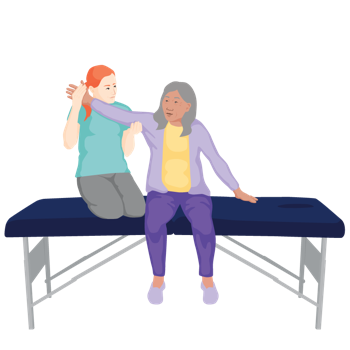Practice
Practice exercises
Once you have demonstrated the exercises to the person, it is important to let them practice what has been taught and correct any issues with technique or answer any questions that the person may have.

Practice sets
Once the person is performing the exercise with correct technique. The person should also practice performing the number of sets you have planned for them.
If the person is feeling okay after the first set, do another set and adjust the resistance or position of the exercise based on the person’s reported exertion and symptoms.
If the person can perform three sets at moderate exertion without significant increase in fatigue or symptoms and is able to maintain the correct technique, this is an appropriate exercise dosage.
![]() Question
Question

Remember Gabriella?
The first time Gabriella was doing muscle strengthening exercises to help manage her ischemic heart disease, she was very fatigued after doing 2 sets of a leg exercise.
The clinician noticed that Gabriella was becoming quite short of breath and was not performing the exercise with a good technique for the last few repetitions of the second set.
Gabriella reported a 9 out of 10 on the BORG RPE scale after 2 sets of the exercise.
Is this an appropriate dosage for Gabriella?
Select all that apply.
- a. Yes
- b. No>
If you selected b, you are correct.
This is not an appropriate exercise dosage for Gabriella as she is experiencing increasing shortness of breath, is exerting herself above an appropriate level and is not performing the exercise with a good technique.
In this scenario, you could adjust the exercise so that Gabriella is not moving against as much resistance.
Monitor exertion, fatigue and symptoms during practice
When the person is practicing exercises, or any time they are performing exercises with you, monitor the person for fatigue by observing and asking the person about their exertion level (using the BORG scale) and symptoms.
Monitor the person’s symptoms, including shortness of breath, discomfort and pain by observing and asking the person.
![]() Question
Question

Remember Jensen?
Jensen is performing muscle strengthening exercises for the first time after being diagnosed with Diabetes.
You have asked him to do a set of 10 repetitions of an exercise against a resistance, he performs the first set with slight exertion, however on the second set he can only manage 8 repetitions before fatiguing.
You would like Jensen to be able to perform 3 sets of 10 repetitions at moderate exertion.
What could be an option to make this exercise more appropriate for Jensen?
Select all that apply.
- a. Keep the exercise the same and he will eventually become less fatigued
- b. Decrease the number of repetitions
- c. Reduce the resistance
- d. Increase the time in between sets
If you selected c, you are correct.
First you should try to reduce the resistance which Jensen is performing the exercise against. Option d. may also help to make the exercise more appropriate, however generally rest in between sets should remain at 1-2 minutes.
